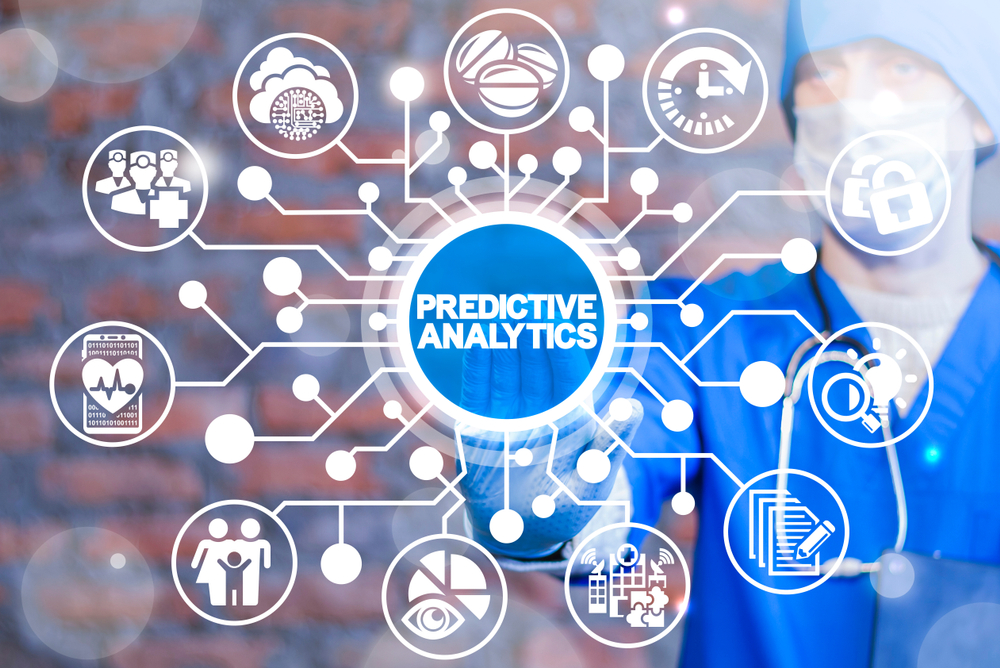Thanks to rapid digital transformation in healthcare, providers now have huge amounts of valuable data at their fingertips. Analysis of this data can provide valuable insights and reveal important trends. That’s why more and more medical organizations are implementing healthcare predictive analytics. It has all the potential to improve both public and personal medical care, reduce the pressure on the industry, and even cut healthcare costs.
Sounds too good to be true? Stay with us.
In this article, we’ll run through the main advantages and use cases of predictive analytics in healthcare. We’ll also explain what implementation challenges you can expect down the road and answer if the rewards are worth the effort.
What is predictive modeling?

Predictive modeling is a form of advanced analytics used for predicting future events. It relies on data mining, machine learning, and artificial intelligence (AI) to detect data correlations and patterns. Based on trends, predictive modeling generates actionable recommendations helping users to gain insights into the subject of the analysis.
Initially, healthcare predictive analytics used medical records, demographical data, patients’ socioeconomic characteristics, and other information to identify high-risk patients and their susceptibility to diseases such as diabetes. But today, the use of predictive analytics in healthcare has gone far beyond just disease estimations and trend visualization. AI models are also used in supply management, clinical trials, and medicine development, and for a good reason.
Benefits of predictive modeling in healthcare

As hospitals shift toward greater digitalization and more patient-centric care, they collect an extensive amount of patient data that can be used in modern analytics strategies, including predictive modeling.
Here are the three most common benefits of using predictive analytics in healthcare.
Better care outcomes
Predictive models at hospitals generate recommendations for doctors relying on all available data sources, including patients’ laboratory results, individual anatomical differences, genetics, allergies, and other medical records that can be otherwise overlooked. This allows medical staff to recognize atypical symptoms faster and to make more accurate diagnoses.
AI-based software can also warn physicians about a patient's risks or drug allergies, improving the efficacy of treatment plans and manipulations.
Another factor affecting care outcomes is proactive treatment, and predictive modeling helps a lot in this domain. Real-time data analysis identifies patients at risk before they show the explicit signs of disease. Based on the possibility of a chronic condition, physicians can focus on preventive treatment and avoid the risk of future complications.
Improved operational efficiency
Predictive modeling applications in healthcare help providers improve patient management and better adjust appointments to the doctors’ schedules. Predictive models can also identify those patients who often skip their appointments. As a result, a provider can reduce schedule gaps, eliminate time-wasting, and prevent staff overload.
With predictive modeling, providers can also anticipate challenges and prepare for them in advance, better allocating resources and supplies. For example, a hospital can anticipate the size of a seasonal flu outbreak and even the number of COVID-19 cases, estimate the number of needed medical personnel, or calculate a patient’s length of stay using AI software solutions.
Cost reduction
The huge amount of available information about patients, staff, schedules, supplies, and equipment gathered in one place helps hospitals cut costs without sacrificing anything important.
For example, more effective care reduces the length of stay and the number of readmissions resulting in fewer operational expenses and penalties. The case of Intel Xeon processor clusters is a perfect illustration of this. The clusters predict patients’ length of stay, helping the hospital group save about $12,000 per patient and allowing each hospital to potentially serve 10,000 patients more every year.
Predictive analytics also helps better anticipate needed resources, including staffing, devices, and materials. Hospitals can reduce inventory costs and optimize stock replenishment by analyzing ordering patterns and supply usage. In the long term, this can improve the efficiency of supply chains, which are often one of the largest expenses of daily operations.
Summing up, the impact of predictive analytics in healthcare is hard to overestimate. Hospitals can deliver more personalized and proactive care, improving treatment efficacy and speed. On a large scale, analytics can help the industry better identify trends and adjust governmental health strategies according to upcoming changes.
Let’s now take a look at some of the brightest examples of how predictive analytics can be used in healthcare.
Predictive modeling examples in healthcare

Predictive modeling isn’t a new thing. It has been used in healthcare since the beginning of the 2000s. But as the technologies behind it evolve, the applications of predictive analytics in healthcare become more versatile. Here are six common examples.
Patient flow prediction
Software enabling predictive analytics can integrate with the hospital management system to analyze patient behavior and recognize patterns. For example, such software can warn about upcoming check-ins or identify those patients who tend to skip their appointments. Better calculations of the number of patients can help hospitals optimize wait times and staffing, improving overall patient satisfaction while avoiding staff overload.
Reducing readmissions
In 2017, UnityPoint Health curbed the readmission rate by 40% within only one and a half years using predictive modeling in healthcare software.
A whopping result considering that the readmission rate is a common indicator of care quality in the US and many European countries. For example, Medicare requires hospitals to pay penalties if a patient comes to the hospital with the same complaints 30 days after the initial admission.
Analytical tools can identify high-risk patients and, even more important, determine what factors put patients into this group. This may include individual health characteristics or even social and behavioral factors that can explain why a patient doesn’t adhere to the treatment plan.
Software with predictive modeling capabilities can provide practitioners with actionable recommendations, guide discharge instructions, and suggest when to arrange a follow-up.
Data security
Predictive analytics can be used to enhance hospitals’ security by identifying security risks. As cyberattacks are getting craftier, predictive analytics and artificial intelligence can come in handy.
AI-enabled software can monitor and analyze hospital systems in real time, which can help identify and raise alerts about uncommon patterns, excessive information exchange, or suspicious access.
Medical imaging
Predictive modeling can automate medical image analysis and save both time and staff resources. For example, AI can be used to identify disease-specific anatomical changes and even the signs of COVID-19 on X-ray images.
Predictive analytics can improve the diagnostics of breast cancer and lung diseases, helping practitioners identify the most vulnerable patients and treat them proactively.
Preventing suicide
More than 700,000 people take their own lives by committing suicide every year, and this number grows by several times if we take into account suicide attempts. Chronic stress and severe depression are common reasons for suicide, which can be prevented by timely medical support.
Predictive analytics in healthcare scans electronic health records (EHR) and mental health visits to identify those patients who are at risk. As a result, hospitals can provide mental health care to such patients or support them through patient portals and hospital applications.
Trial simulation
Predictive modeling can assist in traditional clinical processes by creating computer modeling and simulation without recruiting patients. This testing is called “in silico.” Computers analyze patient-specific data and use it to predict the therapy’s impact on the patient, calculate clinical trial designs, optimize dosing, and predict drug safety and potential adverse effects.
Along with the listed use cases, you can see the use of predictive analytics in health insurance, solutions for patient engagement, healthcare marketing, and other areas. But despite its wide adoption, this technology is still ridden with misconceptions and concerns.
Predictive analytics challenges in the healthcare industry

The most obvious drawback of predictive analytics for healthcare is that we don’t have an accurate definition of what being healthy means. Algorithms rely on accurate measurements, but when it comes to healthcare, there is no one-size-fits-all approach to how we can measure someone’s health.
Modern predictive analytics doesn't rely on traditional statistical approaches and uses new technologies related to deep learning and cognitive computing. This means that new models can better adapt to changes and use more data types for modeling, including images and other media. However, this can also lead to a lack of understanding due to the complexity of the model.
All this causes a number of challenges that hospitals can face when adopting predictive modeling in healthcare software.
Data quality
The more data sources exist, the better algorithms can predict future events. On the other hand, the more data sources a hospital has, the harder it is to verify their quality and accuracy. Some records are unstructured and lack interoperability. Practitioners can transfer diagnosis and treatment plans into EHRs as plain texts instead of filling fields. They can skip some fields or insert incorrect data, which increases the data variability and affects the quality of predictive analytics.
Structured data can also be a problem, though. For example, claims are based on codes for identifying provided services and prescriptions. But these codes don’t provide details on the patient’s health status and tend to unify health data, making it not reliable enough for analysis.
Implementation struggles
Hospitals implement predictive solutions based on EHRs, laboratory and radiology information, customer relationship management (CRM), and other systems to ensure smooth data aggregation. However, post-discharge data often remains out of scope.
Healthcare providers often use surveys or gather data during follow-up appointments, which leaves many factors undocumented and leads to data fragmentation. To avoid this, hospitals may need to integrate solutions for post-discharge data collection, for example, using the Internet of Medical Things (IoMT) and wearables.
One more implementation concern is that a single predictive model rarely satisfies all of a hospital’s needs and delivers reliable predictions. Without verification and regular updates, it can miss data or produce false results. To mitigate risks and improve precision, hospitals may need to use several models that run in parallel, verifying each other's outcomes.
Security concerns
Data privacy and compliance with the Health Insurance Portability and Accountability Act (HIPAA) are the main concerns of any healthcare organization. Integration of predictive modeling can cause risks since hospitals have to take responsibility for mistakes the system can make. The model itself also needs to ensure adequate data security and provide access control, encryption capabilities, and HIPAA-compliant data storage.
If you're on the fence about using predictive analytics in healthcare, you need to understand its capabilities together with its limitations. The good news is that with an experienced team of developers who specialize in medical software solutions, you can overcome most of the challenges down the road. Experts can smoothly integrate hospital systems and increase the quality of the system’s predictions while also ensuring data security and compliance.
Read also: How to prevent data breaches in healthcare.
The future of predictive data analytics in healthcare

Two factors are now reshaping the healthcare environment.
First, digital transformation enables industry players to process more data sources and increase the volume of available electronic health data.
Second, healthcare remains one of the most expensive industries due to the system's inefficiency, the prevalence of chronic conditions, and the growing aging population. In 2020 alone, US healthcare spending exceeded $4 trillion, $12.5 thousand per person.
Predictive analytics, on the other hand, has the potential to reduce healthcare costs, and improve care outcomes and patient satisfaction. According to research, 60% of healthcare executives were already using predictive analytics in 2019, and 20% more were about to start using it in 2020. Now, the healthcare predictive analytics market is expected to grow by seven times, exceeding $28 billion between 2019–2027.
Earlier, only large organizations took advantage of this technology. Today, as the benefits of analytics become undeniable, more small and medium-sized providers are taking it up. In fact, the decision of implementing predictive modeling should be based more on the data volume a hospital accumulates than on the organization’s size or technology complexity—especially if a hospital has a professional development service partner to rely on.
Embrace the future with Demigos
Predictive modeling in healthcare brings a variety of benefits to patients, providers, and payers. The technology improves care outcomes by enabling hospitals to deliver proactive and more personalized treatment, reduce readmissions, and boost patient satisfaction rates. At the same time, using predictive analytics in patient and supply management allows providers to cut their costs and better estimate resources.
A reliable development service vendor can help you alleviate implementation struggles, smoothly integrate software for predictive analytics with hospital systems, and ensure a high level of data security. If this is what you’re looking for, Demigos is here to help. We have extensive expertise in developing complex healthtech and agetech solutions, such as the staffing platform GapNurse and a tech platform for home care, Wendy’s Team.
Take your analytics to the next level with Demigos. Contact us to discuss your project.






